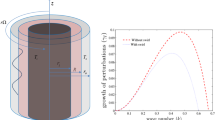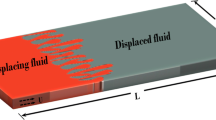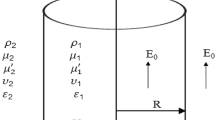Abstract
The behavior of viscous fluid-Walter’s B viscoelastic fluid interface in a planar configuration is investigated through an irrotational flow theory. The interface is transferring heat and mass from one fluid phase to the other. The viscoelastic fluid lies above the viscous fluid, and therefore, the interface is accepting the Rayleigh–Taylor instability. The linear stability theory is employed, and an explicit relationship between perturbation’s growth and wavenumber is established. The implicit stability criterion is achieved and analyzed numerically through the Newton–Raphson numerical scheme. The nature of the interface is examined for various non-dimensional parameters such as Atwood number, Weber number, Froude number, Reynolds number, etc. by means of stability plots. The results are discussed for the various values of gravitational acceleration through the variation of the Froude number. The instability is postponed if the interface experiences more heat transfer. Additionally, compared to the Walter's B fluid interface, the Newtonian fluid interface has proven to be more stable.











Similar content being viewed by others
Availability of Data and Material
Data sharing does not apply to this article as no datasets were generated or analyzed during the current study.
References
Adham-Khodaparast, K., Kawaji, M., Antar, B.N.: The Rayleigh-Taylor and Kelvin-Helmholtz stability of a viscous liquid-vapor interface with heat transport. Phys. Fluids 7, 359–364 (1995)
Asthana, R., Agrawal, G.S.: Viscous Potential flow analysis of Kelvin-Helmholtz instability with mass transfer and vaporization. Physica A 382, 389–404 (2007)
Awasthi, M.K., Shukla, A.K., Yadav, D.: Rayleigh instability of power-law viscoelastic liquid with heat transport. Int. Comm. Heat Mass Trans. 129, 105657 (2021)
Awasthi, M.K., Dharamendra, Yadav, D.: Instability of Rivlin-Ericksen fluid film with heat transport. Int. Comm. Heat Mass Trans. 135, 106085 (2022a)
Awasthi, M.K., Dharamendra, Yadav, D.: Stability characteristics of Walter’s B viscoelastic fluid in a cylindrical configuration with heat transfer. Proc. Inst. Mech. Eng. C: J. Mech. Eng. Sci. 236, 10370–10377 (2022b)
Awasthi, M.K., Asthana, R., Uddin, Z.: Nonlinear study of Kelvin-Helmholtz instability of cylindrical flow with mass and heat transfer. Int. Comm. Heat Trans. 71, 216–224 (2016)
Awasthi, M.K., Asthana, R.: Viscous potential flow analysis of capillary instability with heat transport through porous media. Int. Comm. Heat Trans. 40, 7–11 (2013)
Awasthi, M.K.: Nonlinear Rayleigh-Taylor instability of cylindrical flow with mass transfer through porous media. Int. Comm. Heat Trans. 56, 79–85 (2014)
Awasthi, M.K.: “Kelvin-Helmholtz instability of viscoelastic liquid-viscous gas interface with heat transport” Int. J. Thermal Sci 161, 106710 (2021)
Awasthi, M.K.: Capillary instability of viscoelastic liquid film with heat transport. J. Heat Transf. 142, 022108 (5 pages) (2020)
Awasthi, M.K., Asthana, R., Agrawal, G.S.: Pressure corrections for the potential flow analysis of Kelvin-Helmholtz instability with heat transport. Int. J. Heat Trans. 55, 2345–2352 (2012)
Awasthi, M.K., Agrawal, G.S.: Viscous potential flow analysis of Rayleigh-Taylor instability with heat transport. Int. J. of Appl. Math. and Mech 7, 73–84 (2011)
Awasthi, M.K.: Viscous corrections for the viscous potential flow analysis of Rayleigh-Taylor instability with heat transport. J. Heat Transfer. 135, 071701 (2013)
Dharamendra, Awasthi, M..K..: Temporal instability of Walter’s B viscoelastic fluid film. J. Phys. Conf. Ser. 1849, 012012 (2021)
El-Sayed, M.F.: Electrohydrodynamic instability of two superposed Walters B’ viscoelastic fluids in relative motion through porous medium. Arch. Appl. Mech. 71, 717–732 (2001)
Fu, Q.F., Deng, X.D., Yang, L.J.: Kelvin-Helmholtz instability analysis of confined Oldroyd-B liquid film with heat transport. J. Nonnewton. Fluid Mech. 267, 28–34 (2019)
He, J.H., Moatimid, G.M., Sayed, A.: Nonlinear EHD instability of two-superposed Walters’ B fluids moving through porous media. Axioms 10, 258 (2021)
Ho, S.P.: Linear Rayleigh-Taylor stability of viscous fluids with mass and heat transfer. J. Fluid Mech. 101, 111–127 (1980)
Hsieh, D.Y.: Interfacial stability with mass and heat transfer. Phys. Fluids 21, 745–748 (1978)
Hsieh, D.Y.: Effects of heat transport on Rayleigh-Taylor instability. J. Basic Eng. 94, 156–160 (1972)
Isobe, H., Miyagoshi, T., Shibata, K., Yokoyama, T.: Filamentary structure on the Sun from the magnetic Rayleigh-Taylor instability. Nature 434, 478–481 (2005)
Kim, B.J., Kim, K.D.: Rayleigh-Taylor instability of viscous fluids with phase change. Phys. Rev. E 93, 043123 (2016)
Kim, H.J., Kwon, S.J., Padrino, J.C., Funada, T.: Viscous potential flow analysis of capillary instability with heat transport. J. Phys. A Math. Theor. 41, 335205 11pp (2008)
Kumar, P., Singh, G.J.: On the stability of two stratified Walters B’viscoelastic superposed fluids. Studia Geotechnica Et Mechanica 32, 29–38 (2010)
Lewis, D.J.: The instability of liquid surfaces when accelerated in a direction perpendicular to their planes II. Proc. Royal Soc. London Series A 202, 81–96 (1950)
Madani Tonekaboni, S.A., Abkar, R., Khoeilar, R.: On the study of viscoelastic Walters' B fluid in boundary layer flows. Math. Probl. Eng. 2012, 861508 (2012)
Moatimid, G.M., Mostapha, D.R., Zekry, M.H.: Nonlinear EHD stability of cylindrical Walters B’ fluids: effect of an axial time-periodic electric field. Chin. J. Phys. 74, 106–128 (2021)
Moatimid, G.M., Zekry, M.H.: Nonlinear stability of electro-visco-elastic Walters’ B type in porous media. Microsyst. Technol. 26, 2013–2027 (2020)
Moatimid, G.M., Zekry, M.H., Gad, N.S.: Nonlinear EHD instability of a cylindrical interface between two Walters B’ fluids in porous media. Journal of Porous Media 25, 11–34 (2022)
Postelnicu, A.: Thermal hydrodynamic instability of a Walters B viscoelastic fluid in a fluid-saturated an isotropic porous medium with fast chemical reaction. In Proceedings of the 81st EUROTHERM Seminar on Reactive Heat Transfer in Porous Media, Ecole des Minesd’Albi, France (2007)
Rayleigh, L.: Investigation of the equilibrium of an incompressible heavy fluid of variable density. Proc. Royal Soc. London 14, 170–177 (1882)
Sharma, R.C., Kumar, P.: On the stability of two superposed Walters B′ viscoelastic liquids. Czech J. Phys. 47, 197–204 (1997)
Straub, J.: The role of surface tension for two-phase heat transport in the absence of gravity. Exp. Thermal Fluid Sci. 9, 253–273 (1994)
Taylor, G.I.: The instability of liquid surfaces when accelerated in a direction perpendicular to the planes I. Proc. Royal Soc. London Series A 201, 192–196 (1950)
Wang, X.T., Ning, Z., Lu, M.: Temporal instability analysis of a confined non-Newtonian liquid jet with heat transport. European Journal of Mechanics / B Fluids 84, 350–356 (2020)
Walters, K.: Non-Newtonian effects in some elastic-viscous liquids whose behavior at small rates of shear is characterized by a general linear equation of state. Quart. J. Mech. App. Math 15, 63–76 (1962a)
Walters, K.: The solution of flow problems in case of materials with memory. J. Mecanique 1, 469–479 (1962b)
Yamanaka, C.: Inertial confinement fusion: The quest for ignition and energy gain using indirect drive. Nucl. Fusion 39, 825 (1999)
Funding
A.K.S. is thankful to University Grants Commission (Ref. No. 1274/ (CSIR-UGC NET JUNE 2019) for financial support. S.S. acknowledges funding through the German Research Foundation within the research unit DFG–FOR5409.
Author information
Authors and Affiliations
Contributions
Atul Kumar Shukla: Writing - original draft Mukesh Kumar Awasthi: Conceptualization; Methodology; Software Satyvir Singh: Writing - review & editing.
Corresponding author
Ethics declarations
Ethics Approval
All the authors mentioned in the manuscript have agreed to authorship.
Consent to Participate
All the authors mentioned in the manuscript have read and approved the manuscript and given consent for submission.
Consent for Publication
All the authors mentioned in the manuscript have given consent for submission and subsequent publication of the manuscript.
Conflicts of Interest
There is no conflict of interest.
Additional information
Publisher's Note
Springer Nature remains neutral with regard to jurisdictional claims in published maps and institutional affiliations.
Appendices
Appendix A
The equation \(y=\Upsilon (x,t)\) represents the interface position in the perturbed state and hence, the interface equation \(f(x,y,t)=y-\Upsilon (x,t)=0\). Then the mass transfer Eq. (6) can be written as
Retaining linear terms only, one can get Eq. (12) as
Appendix B
Equation (7) is given as
The interface in basic and perturbed states can be given as \(y=0\), and \(y=\Upsilon (x,t)\). In the perturbed state, the net heat flux is given as \(H(y=\Upsilon )\), and expanding this term about \(y=0\) through Taylor’s series expansion, we have
As in the basic state, the net heat flux is zero because the interface is taken in saturation state, and therefore,
Hence, equation (B.1) becomes
Retaining only linear terms, one can get the Eq. (13) as
Here \({H}^{^{\prime}}(0)={\left[{H}^{^{\prime}}(\Upsilon )\right]}_{\Upsilon =0}\) can be obtained as follows;
Appendix C
The perturbed flow is considered as irrotational and therefore, \({\varvec{V}^{^{\prime}}}_{w}=\nabla {{\varphi }^{^{\prime}}}_{w},\varvec{V}_{v}=\nabla {{\varphi }^{^{\prime}}}_{v}\). The velocity components can be expressed as \(({{u}^{^{\prime}}}_{w},{{v}^{^{\prime}}}_{w})=\left(\frac{\partial {{\varphi }^{^{\prime}}}_{w}}{\partial x},\frac{\partial {{\varphi }^{^{\prime}}}_{w}}{\partial y}\right)\), \(({{u}^{^{\prime}}}_{v},{{v}^{^{\prime}}}_{v})=\left(\frac{\partial {{\varphi }^{^{\prime}}}_{v}}{\partial x},\frac{\partial {{\varphi }^{^{\prime}}}_{v}}{\partial y}\right)\). The momentum equations in Eq. (10) can be expressed in the irrotational flow as
Then, we obtain
Further, after integrating this equation, we can obtain.
In a similar fashion, we can obtain
In the basic state, the pressure was the same in both phases, and therefore, C1 = C2 and these constants will cancel out as we take the pressure difference. Hence, the gravitational acceleration will be included through pressure terms.
Rights and permissions
Springer Nature or its licensor (e.g. a society or other partner) holds exclusive rights to this article under a publishing agreement with the author(s) or other rightsholder(s); author self-archiving of the accepted manuscript version of this article is solely governed by the terms of such publishing agreement and applicable law.
About this article
Cite this article
Shukla, A.K., Awasthi, M.K. & singh, S. Impact of heat and mass transport on Rayleigh–Taylor instability of Walter’s B viscoelastic fluid layer. Microgravity Sci. Technol. 35, 3 (2023). https://doi.org/10.1007/s12217-023-10031-6
Received:
Accepted:
Published:
DOI: https://doi.org/10.1007/s12217-023-10031-6




